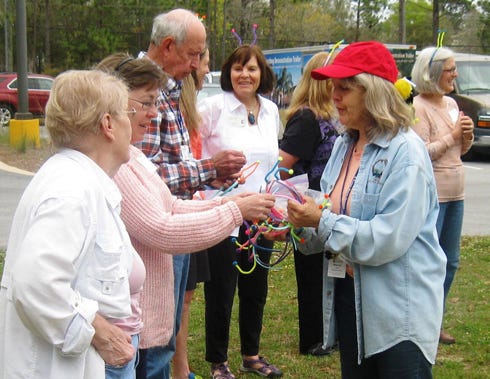
CRESTVIEW — When a wasp crawls around your fig tree, don’t swat it. It’s doing its part to assure the tree keeps producing figs.
Home gardeners are generally unaware of how many plant species depend on pollination, and how many critters do the job, Okaloosa County Master Gardener Stacy Taylor said.
“What’s pollination?” Taylor said. “It’s sex, that’s what it is.”
Pollination is technically the transfer of plant sperm to plant ovaries via pollen, Taylor said.
That’s done by transferring pollen grains from a plant’s stamen to its pistil. To do that, gardeners and farmers need pollinators.
Wasps crawl around a front-yard fig tree and, incidentally, lose their antenna and wings trying to get through the fruit to the flower inside.
“So when we’re eating figs, we’re also eating that stuff,” Taylor said. “Isn’t that something to think about.”
Local pollinators also include bees, moths, bats, birds, flies, slugs, gnats and beetles, which, perhaps surprisingly, are more responsible for pollinating than any of the others, Taylor said.
Ants you could go ahead and squish.
“Ants aren’t very efficient pollinators,” she said. “Their feet aren’t furry so not much sticks to them,” and besides, ants produce a substance on their shells that actually kills pollen.
As residents wash their cars and porches of spring’s annual yellow pine pollen dusting, they’re also responding to one of Northwest Florida’s other pollinators: the wind.
In our area, pollination occurs all year, benefiting multiple species. And “flowers,” which are integral to the process, aren’t always the brightly colored, gently waving, pleasant-smelling things in the garden.
Remember that wasp burrowing through the fig to get to the flower inside?
“Flowers have specialized beyond what we could ever imagine,” Taylor said. That includes generating electrical fields to let bees know when their nectar is ready for sipping. “That’s something to think about the next time you’re looking at your pretty flowers.
“Nothing happens by chance.”
—
North Okaloosa County plants that rely on pollinators include beans, blackberries, black-eyed peas, blueberries, cotton, grapes, honey, loquats, okra, peppers, potatoes, pumpkins, squash, strawberries, tomatoes and watermelon. Corn, peanuts and pecans self-pollinate or are wind pollinated. Local pollinators include honey bees, bumblebees, beetles, birds, butterflies, moths and wasps.
North Okaloosa County plants that rely on pollinators include beans, blackberries, black-eyed peas, blueberries, cotton, grapes, honey, loquats, okra, peppers, potatoes, pumpkins, squash, strawberries, tomatoes and watermelon. Corn, peanuts and pecans self-pollinate or are wind pollinated. Local pollinators include honey bees, bumblebees, beetles, birds, butterflies, moths and wasps.
DID YOU KNOW?
This article originally appeared on Crestview News Bulletin: North Okaloosa pollination is a year-round process (VIDEO)
